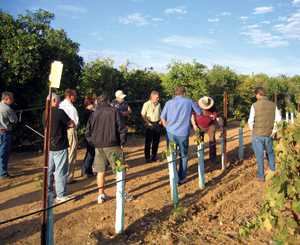Research Focus On Warding Off Pierce’s Disease

Winegrape plantings at a Temecula test plot consist of six different varietals spread out among three sites. Each site has one varietal known to be very susceptible to Pierce’s disease, while the other varieties are less susceptible. The team expects to see the first symptoms of Pierce’s disease in vines by next August if the disease pressure is decent. Note the organic orange grove adjacent to the test plot, which creates a “perfect storm” for disease pressure.
Imagine a shot that would prevent grapevines from getting Pierce’s disease (PD). While the concept may seem far-fetched, one scientist in Florida has shown very positive results that could lead to just that — a PD shot for vines.
For the past 20 years, Donald L. Hopkins, a professor of plant pathology with the Mid-Florida Research & Education Center, has been working with benign strains of Xylella fastidiosa (Xf). This bacterium causes PD in grapevines and leaf scorch in almonds, and utilizing benign strains as a control method is getting some very positive results.
“We began to conduct greenhouse tests on biocontrol with benign strains of Xf around 1990,” says Hopkins. “We did our first vineyard test at the University of Florida research vineyard in Leesburg in the spring of 1992 using an American hybrid grape, Himrod. Next, we did a large-scale test in the University of Florida vineyard in a new planting of Cabernet Sauvignon/Freedom in the spring of 1997. Then we put our first test plots in at a Florida commercial vineyard in 2004.”
In much the same way that children are given smallpox vaccinations to ward off the onset of the disease later in life, Hopkins discovered a strain of Xf that does not produce symptoms in infected grapevines and wards off PD in the vines. The difference between the vaccination for humans and the shot for vines is that the vine does not have an immune system like humans. What actually happens is that the benign Xf invades and infects the vine, but it is a strain that doesn’t produce any symptoms. With the benign strain occupying the plant, the vine becomes resistant to PD. The result is a vine that is symptomless and continues to produce grapes.
Going To California
Many of the plants native to California are symptomless when infected with the same strain of Xf that kills grapevines. The California Department of Food and Agriculture’s Pierce’s Disease/Glassy-Winged Sharpshooter Board has been funding research efforts to impart that same trait to winegrape vines. Hopkins’ efforts effectively get the same results — healthy vines that continue to produce grapes in an environment filled with PD — but use a totally different approach.
In the late 1980s, Hopkins observed that strains of Xf would lose virulence in culture; however, some of these strains could still colonize the grapevine to a certain degree. “We also observed that some isolates of Xf obtained from hosts other than grapes could colonize grapevines without causing symptoms. Because of other research publications on cross protection for disease control, I decided to evaluate the effect on disease incidence and severity by inoculating grapevines with the benign strains prior to inoculating with pathogenic strains.”
Hopkins said that after many greenhouse and vineyard tests, the EB92-1 strain of Xf proved the most effective strain for biocontrol and the most consistent from test to test. This spring, field trials using the benign Xf strain moved to California thanks to funding from the PD/GWSS Board. A total of 600 vines have been planted so far. The first planting of 200 vines is in an organic vineyard in Temecula. A second planting of 200 vines is in Sonoma and a third in Napa.
Bruce Kirkpatrick, a plant pathologist at University of California-Davis, is heading up the California project. “Half of the vines are inoculated with the benign Xf and the other half were left untreated,” says Kirkpatrick. “The project is planned for five years, unless everything gets infected sooner. Otherwise, I’d say that when well over half of the nonprotected vines develop PD, we’ll have enough data to statistically analyze.”
The test plantings consist of six different varietals spread out among the three sites. Each site has one varietal known to be very susceptible to PD, while the other varieties are less susceptible. “We expect to see the first symptoms of PD in vines by next August if the disease pressure is decent,” says Kirkpatrick, who added that even if the tests are successful, winegrape growers needn’t be in the market for a hypodermic set just yet.
“If these tests are successful, the next step will be performing larger tests with more varietals,” he said. “Then once the industry decides that this is a control method they want to embrace, there will be more tests to determine the best method for commercially deploying the benign strain in both new and existing vineyards.”
Déjà Vu All Over Again
Glassy-winged sharpshooter (GWSS) numbers in the California winegrape region Temecula are on the rise, according to Nick Toscano, a University of California-Riverside Cooperative Extension entomologist. The numbers of GWSS, which spreads the incurable Pierce’s disease, are almost equal to 2001, the year the highest numbers were observed.
In a recent presentation to the Pierce’s Disease/Glassy-Winged Sharpshooter Board, Toscano showed a PowerPoint slide titled “Déjà Vu All Over Again,” which listed the following four factors contributing to the increase: weather, urbanization, riparian areas, and untreated grape and citrus acreage.
The good news, according to Toscano’s presentation, is that neonicotinoid insecticides have proved effective against the hardy pest. Careful timing of applications of the neonicotinoids could impact all GWSS stages. Among the neonicotinoids Toscano listed were: AdmirePro (imidacloprid, Bayer CropScience), Alias (imidacloprid, MANA Crop Protection), Platinum (thiamethoxam, Syngenta Crop Protection), and Venom (dinotefuran, Valent U.S.A.)










